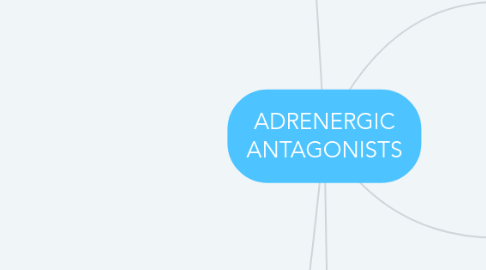
1. ALPHA ADRENERGIC RECEPTOR ANTAGONISTS
1.1. Alpha-1 blockers (selective)
1.1.1. Prazosin
1.1.1.1. Pharmacokinetics
1.1.1.1.1. Oral
1.1.1.1.2. Metabolism: Liver
1.1.1.1.3. Elimination: Biliary, Feces
1.1.1.1.4. Half-life: 2-3 hrs
1.1.1.2. Pharmacodynamics
1.1.1.2.1. Inhibit postsynaptic alpha-1 adrenoreceptor (vascular smooth muscle)
1.1.1.2.2. Major effect on arterioles & veins
1.1.1.3. Clinical Indications
1.1.1.3.1. Hypertension
1.1.1.3.2. BPH
1.1.1.4. Adverse effects
1.1.1.4.1. Dizziness or Lightheadedness
1.1.1.4.2. Fainting (sudden)
1.1.1.4.3. Urinary incontinence
1.1.1.4.4. Palpitation
1.1.1.4.5. Edema
1.1.1.5. Side Effects
1.1.1.5.1. Drowsiness
1.1.1.5.2. Headache
1.1.1.5.3. Weakness
1.1.1.6. Risk factor
1.1.1.6.1. Upright posture
1.1.1.6.2. Volume depletion
1.1.1.6.3. Taking BP-lowering drugs
1.1.1.7. Management
1.1.1.7.1. Take w lower dose
1.1.1.7.2. Take 1st dose at bedtime
1.1.2. Alfuzosin
1.1.2.1. Pharmacokinetics
1.1.2.1.1. Oral
1.1.2.1.2. Metabolism: Liver
1.1.2.1.3. Elimination: Renal, Feces
1.1.2.1.4. Half life: 10 hrs
1.1.2.2. Adverse effect
1.1.2.2.1. Dizziness
1.1.3. Terazosin
1.1.3.1. Pharmacokinetics
1.1.3.1.1. Oral
1.1.3.1.2. Metabolism:Liver
1.1.3.1.3. Elimination: Feces, Renal
1.1.3.1.4. Half life: 12 hrs
1.1.3.2. Adverse effect
1.1.3.2.1. Dizziness
1.2. Non-selective alpha blocker
1.2.1. Phenoxybenzamine
1.2.1.1. Pharmacokinetics
1.2.1.1.1. Oral
1.2.1.1.2. Metabolism: Liver
1.2.1.1.3. Elimination: Renal, Biliary
1.2.1.1.4. Duration: 24 hrs
1.2.1.2. Pharmacodinemics
1.2.1.2.1. Non-selective irreversible antgonist
1.2.1.2.2. Blocking alpha receptors
1.2.1.3. Clinical indications
1.2.1.3.1. Hypertension in pheochromocytoma
1.2.1.3.2. Reducing vasoconstriction caused by A & NA
1.2.1.4. Side effects
1.2.1.4.1. Postural (Orthostatic) hypotension
1.2.1.4.2. Reflex tachycardia
1.2.1.4.3. Nasal congestion
2. BETA ADRENERGIC RECEPTOR ANTAGONISTS
2.1. Selective beta-1 blockers
2.1.1. Atenolol, Metoprolol (general)
2.1.1.1. Pharmacodynamics
2.1.1.1.1. Beta-1 selective (cardioselective)
2.1.1.1.2. Competitive antagonist at beta-1 adrenoreceptor in heart
2.1.1.1.3. Decrease in HR, cardiac output & BP
2.1.1.1.4. Beta-1 effect
2.1.1.1.5. Less Beta-2 effect
2.1.2. Atenelol
2.1.2.1. Pharmacokinetics
2.1.2.1.1. Oral
2.1.2.1.2. Metabolism: Liver (minimal)
2.1.2.1.3. Elimination: Renal, Feces
2.1.2.1.4. Half life: 6-7 hrs
2.1.2.2. Adverse effects
2.1.2.2.1. Blurred vision
2.1.2.2.2. Cold hands or feet
2.1.2.2.3. Confusion
2.1.2.2.4. Difficult or Labored breathing
2.1.2.2.5. Dizziness, Faintness, Lightheadedness when getting up from lying or sitting position suddenly
2.1.2.2.6. Shortness of breath
2.1.2.2.7. Sweating
2.1.2.2.8. Tightness in chest
2.1.2.2.9. Unusual tiredness or weakness
2.1.2.2.10. Wheezing
2.1.3. Metoprolol
2.1.3.1. Pharmacokinetics
2.1.3.1.1. Oral
2.1.3.1.2. Metabolism: Liver
2.1.3.1.3. Elimination: Renal
2.1.3.1.4. Half life: 3-7 hrs
2.1.3.2. Adverse effects
2.1.3.2.1. Blurred vision
2.1.3.2.2. Chest pain or discomfort
2.1.3.2.3. Confusion
2.1.3.2.4. Dizziness, Faintness, Lightheadedness when getting up suddenly from lying or sitting position
2.1.3.2.5. Shortness of breath
2.1.3.2.6. Slow or irregular heartbeat
2.1.3.2.7. Sweating
2.1.3.2.8. Unusual tiredness or weakness
2.2. Non selective beta blocker
2.2.1. Propranolol
2.2.1.1. Pharmacokinetics
2.2.1.1.1. Oral & IV
2.2.1.1.2. Metabolism: Liver
2.2.1.1.3. Elimination: Urine
2.2.1.1.4. Half life: 4 hrs
2.2.1.2. Pharmacodynemics
2.2.1.2.1. Equally affinity
2.2.1.2.2. Competes w sympathomimetic neurotransmitters (catecholamines) for binding at beta-1 adrenergic receptors in heart
2.2.1.2.3. Effect of blocking beta-1
2.2.1.2.4. Effect of blocking beta-2
2.2.1.3. Adverse effects (more common in children)
2.2.1.3.1. Cough producing mucus
2.2.1.3.2. Breathing difficulty
2.2.1.3.3. Chest tightness
2.3. Clinical indication
2.3.1. Hypertension
2.3.2. Inhibition of renin released from kidney
2.3.3. Angina
2.3.4. Congestive heart failure
2.3.5. Cardiac arythmia
2.4. Precautions
2.4.1. Care in bronchoconstrictive disease
2.4.2. Caution in peripheral vascular disease
2.4.3. Caution in patients with heart conduction defects or anti-arythmatic drugs
2.4.4. Withdrawal syndrome
2.4.5. Caution in diabetes mellitus
3. INTRINSIC SYMPATHOMIMETIC ACTIVITY (ISA)
3.1. Antagonist with partial agonist activity
3.2. Pindolol
3.2.1. Nonselective beta blocker with ISA
3.3. Acebutolol
3.3.1. Cardioselective betablocker with ISA
3.4. Clinical indications
3.4.1. Excessive bradycardia with sustained beta blocker therapy
3.4.1.1. Congestive heart failure
